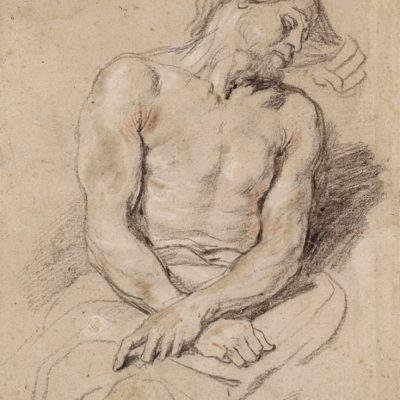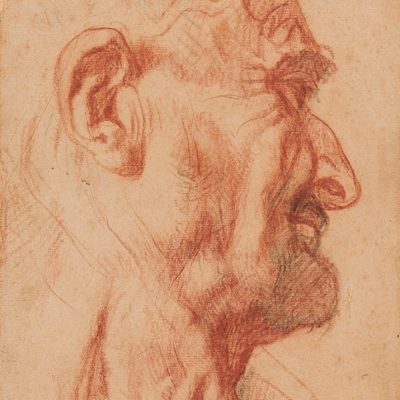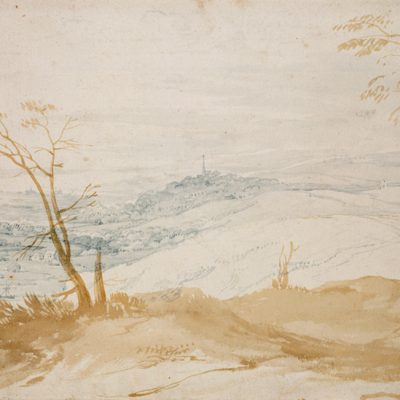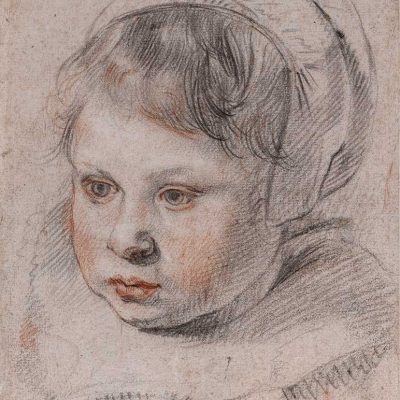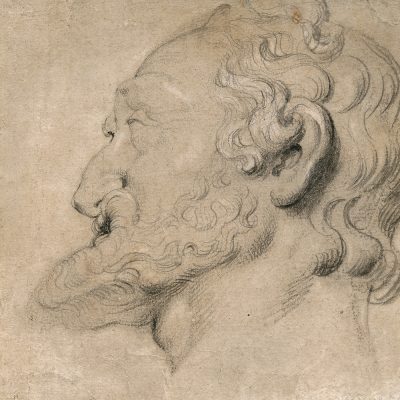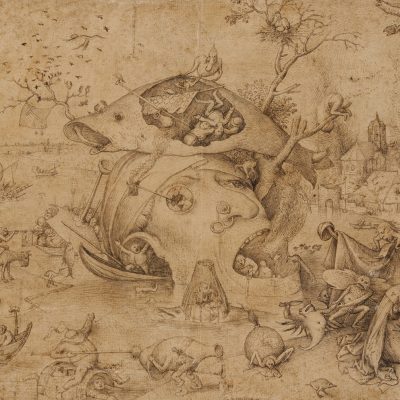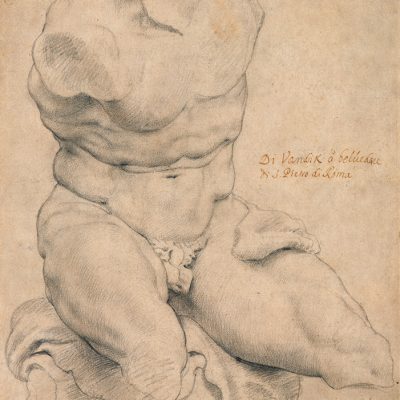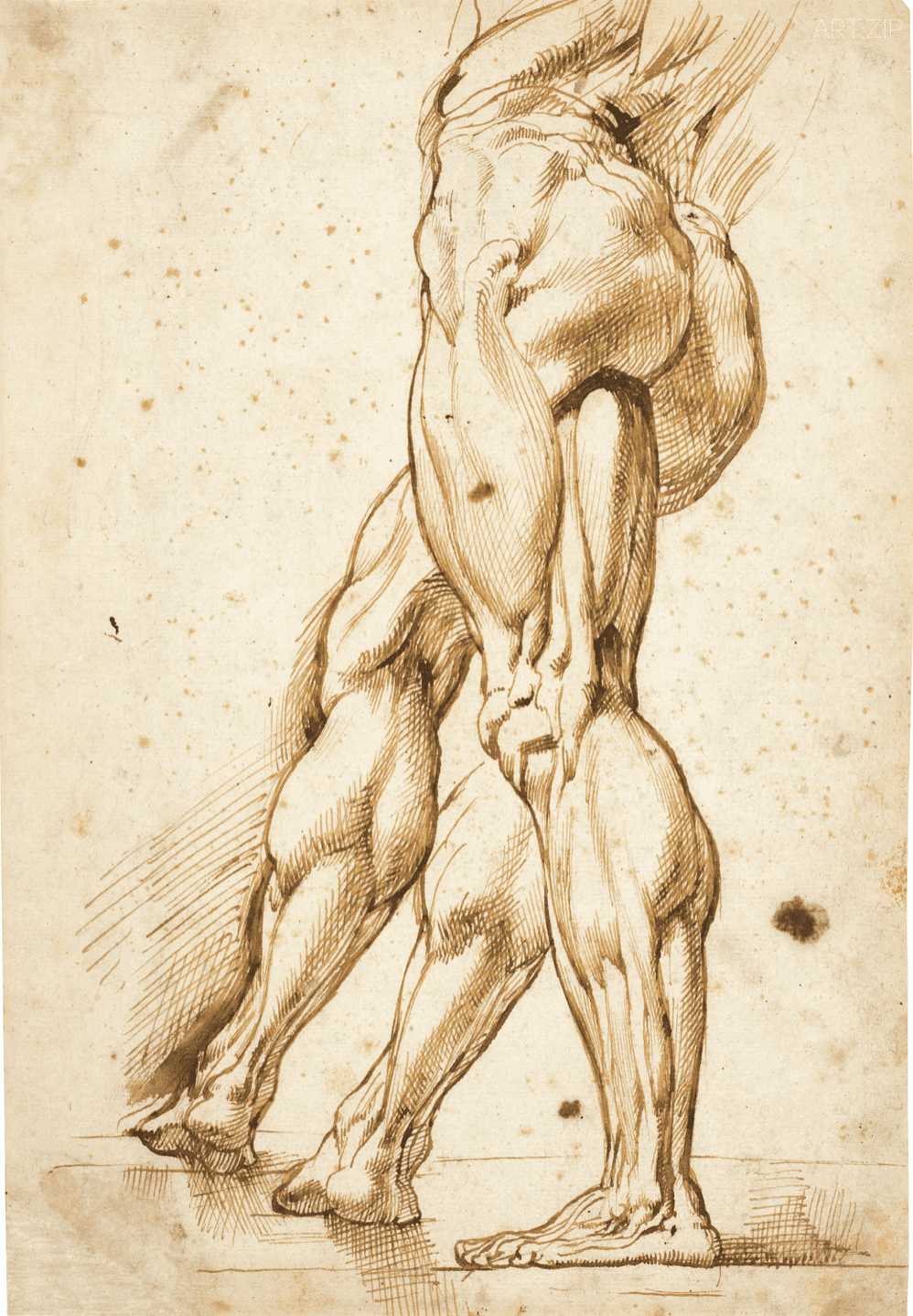
Brugel to Rubens
Great Flemish Drawings
Ashmolean Museum, Oxford
23 March – 23 June 2024
There is a drawing by Rubens of a torso of a man with three legs (1600-1608) that is being exhibited as part of an exhibition at the Ashmolean Museum in Oxford of Flemish Drawings. Obviously, Rubens was attempting to work out the position of a leg for a painting. It was as if each of these legs had a claim to becoming the final realisation of the position. The presentation of three legs simultaneously provides the imagination with options and perhaps this is what drawing offers in the form of the multiplicity of options in advance of final appearance. All three legs each have a potential place, but a choice is to be made because only two legs will suffice within the design of the final painting.
在牛津的阿什莫林博物館(Ashmolean Museum)舉行的佛蘭德斯素描展上,展出了一幅魯本斯(Rubens)創作於1600-1608年的男人軀幹素描。畫中人物擁有三條腿,這顯然是魯本斯為畫作構圖時,用於確定腿部最終位置的嘗試。彷彿每一條腿都在競逐,渴望成為最終定稿的一部分。這三條腿同時存在,為觀者的想像力打開了多種可能性。而這或許正是素描的魅力所在:在最終形象確定之前,將選擇的多樣性以視覺化的方式展現出來。每一條腿都擁有潛在的歸屬位置,但終究需要做出選擇,因為在最終的畫面設計中,兩條腿就已足夠。

Sketch of the muscle of a leg by Peter Paul Rubens
X-Rays of paintings often show the choices made within the underpainting which might have been made in the form of this arm or another arm, this gesture rather than another, revealing in turn the exercises in imaginative deduction or refinement. Drawing then as process brings the viewer close to the working of imagination or intuition, as opposed to the more definitive forms of representation based on established cognitive ordering of things. Like the hidden art of schematism, drawing is like a form of hidden art that invariably did not necessarily become exposed, and as such were left in the pages of private sketchbooks of artists in question. This in turn gave rise to the feeling of drawings intimate relationship to the thinking process of the artist.
Within Modernity a persistent question posed is that of the relationship between drawing and painting, which in turn reveals the relationship between public and private. The degree to which this question was exposed within the aesthetic process was also related to the exposure of the subject itself, but it was one that could be seen to alter the very status of drawing as a practice. It might be that a double exposure started to be mediated within drawing, that of both a question and that of a reflex or gesture. Also, within this a shift is affected in the relationship between the academic status of drawing whereby drawing was understood as a repository of research insights that propel into the very heart of aesthetic desire, or the sense of agency or voice which might be assumed. It is as if drawing shifts from being behind each completed artwork, to becoming its own centre, affecting a shift from being that which underlies, with that is distributed through all the different aspects or manifestations of art. So drawing is not only the question of its relation, (to painting and the self) but one which contains a sense of the expansion or distribution of it. Thus, when writing itself enters, not only in relationship as medium, but a new feeling of distribution occurs because of this shift, that enables an expanded sense for an outlet for the figuring of the figure. Therefore, drawings plasticity is enhanced and with this transformative medium for a whole number of folds, the fold of painting, the fold of subjectification, and the fold of writing is the creative outcome. With this, drawing moves from being a minor form, to one that disturbs or redistributes a relationship such as of minor and major.
繪畫的X光檢測常常揭示底層畫稿中的選擇——是這隻手臂還是另一隻?是這個動作還是那個動作?這些選擇展現了藝術家在創作過程中進行的想像推演與精細修正。素描作為創作的過程,讓觀者得以貼近藝術家想像力與直覺運作的脈動,這與基於既定認知秩序的明確再現形式截然不同。素描如同一種隱秘的圖式藝術,往往未能完全展現於世,而是停留在藝術家的私人素描本中,成為一種未曝光的創作軌跡。因此,素描與藝術家思考過程之間的親密關係得以彰顯,激發出一種深刻而獨特的共鳴。
在現代性中,一個持續被探討的問題是素描與繪畫之間的關係,而這又進一步揭示了公共與私密之間的聯繫。在美學過程中,這一問題的顯現程度與主體自身的「暴露」息息相關,同時也重新定義了素描作為創作實踐的地位。可以說,素描內部調解了一種雙重的「暴露」——既是問題的呈現,也是反射與姿態的表達。這一過程也帶來了素描學術地位的轉變。素描不再僅僅是研究洞察的儲存庫,而是深入美學慾望的核心,揭示出創作者的能動性與聲音。素描彷彿從每一件完成作品背後的支撐角色,轉變為自身的創作中心——從「基礎」變為分布於藝術各種表現形式中的核心存在。因此,素描不僅涉及它與繪畫(或自我)之間的關係,也蘊含著一種擴展性與分布感的潛能。當書寫作為媒介加入其中時,這種擴展性更進一步。它不僅改變了媒介之間的關係,還帶來了一種新的分布感,為「形象」的呈現開闢了更廣闊的出口。素描的可塑性因此得到增強,成為多重層面的轉化媒介——包括繪畫、主體化,以及書寫,這些層面共同構成創造性成果的完整性。隨著這一變化,素描不再僅僅是一種次要形式,而成為擾動甚至重新分配「次要與主要」關係的核心力量。
The notebook drawings of Artaud, the calligraphic paintings of Twombly or the work of Joan Mitchell, Jean-Michel Basquiat, each in their own way serve to establish chains of drawing-painting-writing. There is within this an eruptive quality, or a breaking free of a restrictive code, and with this either a contraction of the space in-between these registers or an opening out a new rhymical accord that stretches out or pulls together within a greater sense of inscriptive intensity. If drawing had served as a schematic, observational, and expressive coding of recollection and registration, then one of the implications of this further complexity serves also the way in which the shifting system of signification within the potentiality of drawing becomes operative. The coding of drawing practice might serve as a model for its own mutation in or over time because of the way drawing never held itself up to the scrutiny of being a completed object. Drawing in this regard might be claimed to not only be in accord to the transience of its as medium but to be the very delicacy of being able to provide transience with a system of make itself visible through marks or inscriptions.
There was always something other within drawing. When lenses started to be employed, the impact of this was to repress this space of the in-between of drawing and proceed directly to the completed object. A testimony to this was that Vermeer left no trace of having a drawing practice whereas Rembrandt left thousands. This was surely due to the employment of lenses to establish the image. The difference between a Rembrandt painting and a Vermeer painting is telling in this regard and it is as if we are viewing quite different objects especially in regard to the actual relationship to the durational figuring on the image. The layers of paint within A Rembrandt painting, especially in late Rembrandt record a density of revisions, corrections, and insights as if a painting can record the totality of each of the shifts implicated within its textual surface. All of this is repressed within Vermeer which draws them close to the advent of the photographic code.
We are now not just a lens saturated culture, but one of virtual reality and this provides a form of counter narrative to our relationship to inscriptive practices. Partly the response to drawing is formed as trying to understand the difference between the manual and the machinic. In someway this connects to the sensitivity attached to perceived history of drawing that comes with a perceived threat to its status within the aesthetic process. Virtual drawing processes carries within it the elimination of the fugitive and contingent aspects of manual drawing. Perhaps this drawing by Rubens might inflect upon such perceptions, even though this would be without its design to do so. This is why we might look at drawing within the present as being an offering of another mode of destiny for the visual. The technological regime operates as an imperialistic operation transforming the textual interface of the image which eliminates the delay in the perceptual process that it offers. Historically drawing functioned as a pause for thought that expanded the sense of medium.
Drawings future relates to, whether we can elect which ground we are standing on and with this the ability to cognize this as an offering. This might appear as an insignificant freedom but one that requires our attention.
阿爾托(Artaud)的筆記本素描、托姆布雷(Cy Twombly)的書法式繪畫,以及瓊·米切爾(Joan Mitchell)和尚·米榭·巴斯奇亞(Jean-Michel Basquiat)的作品,各自以獨特的方式構建了素描、繪畫與書寫之間的連結。這些作品中蘊含著一種爆發性的力量,或者說是一種衝破限制性編碼的解放過程。由此,這些表現形式之間的「中間空間」要麼被壓縮,要麼被擴展,從而形成一種新的韻律和諧——既拉伸又凝聚,展現出更加強烈的書寫密度感。如果說素描過去被視為一種圖式化、觀察性與表達性編碼的記錄形式,那麼這種進一步的複雜性揭示了素描如何在符號化系統的流動性中,轉化為一種具有操作性的潛能。正是因為素描從未將自己固定為「完成品」,它的編碼實踐才得以成為自身在時間中發生變異的模型。因此,素描不僅契合其作為媒介的暫時性,更成為一種能為「暫時性」提供可見形式的精妙系統。它通過筆觸與書寫,將這種暫時性捕捉、記錄並可視化,為藝術創造開闢了更多可能性。
素描中始終蘊藏著某種「他者」的存在。然而,當透鏡* 開始被用於創作時,其影響在於壓抑了素描中那種「中間狀態」的空間,直接指向完成的作品。最明顯的例證是:維梅爾(Vermeer)幾乎沒有留下任何素描的痕跡,而倫勃朗(Rembrandt)卻留下了數千幅。這種差異顯然與透鏡的使用密切相關,因為透鏡被用來直接確立圖像的構圖。從這一視角出發,倫勃朗與維梅爾的繪畫呈現出截然不同的特質。它們彷彿屬於完全不同的類型,尤其是在圖像生成的持續性過程中。倫勃朗的作品,特別是他晚期的畫作,以層層塗繪的痕跡記錄了修訂、改正與洞察的密度,就如同一幅畫能夠承載其表面每一次轉變的全部歷程。而在維梅爾的畫作中,這些過程被徹底壓抑,轉而引向一種近乎「攝影編碼」(photographic code)的形式。
我們如今不僅身處一個透鏡充斥的文化,更步入了虛擬現實的時代。這一時代為我們與書寫性實踐之間的關係提供了一種對立敘事。對於素描的回應,部分來自於對手工與機械差異的探索,而這又與人們對素描歷史的敏感性息息相關——一種認為素描在美學過程中所建立的地位正受到威脅的感知。虛擬素描的出現消解了手工素描中短暫性與偶然性的特質。而魯本斯(Rubens)的這幅素描或許能對這種感知產生某種影響,儘管它並非為此而設計。正因如此,素描在當下成為了一種契機——一種為視覺提供全新「命運模式」的可能性。技術化體制作為一種帝國式的運作方式,徹底改造了圖像的文本界面,並消除了感知過程中的延遲感。而這延遲,恰恰是素描在歷史上所提供的:一種思考的停頓,從而擴展了媒介的意義。
素描的未來取決於我們是否能選擇自己的立足點,並將這一選擇認知為一種提案。這種選擇或許看似微不足道,但它蘊含著一種值得我們關注的自由。
*這裡的「透鏡」具體指「光學技術(如凸透鏡或暗箱)」在藝術創作中的應用。透鏡的使用讓維梅爾可以精確地捕捉和描繪現實,而倫勃朗則更加注重創作過程中的試驗性與表達的直覺性。這種技術上的分歧進一步加深了兩人作品在美學和技法上的差異。
Text by Jonathan Miles

